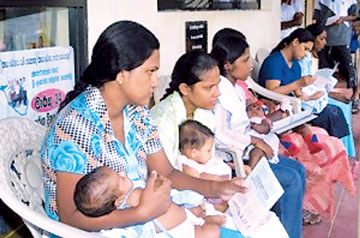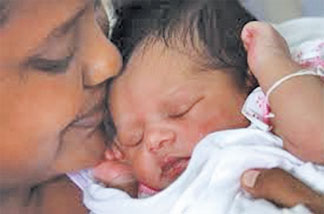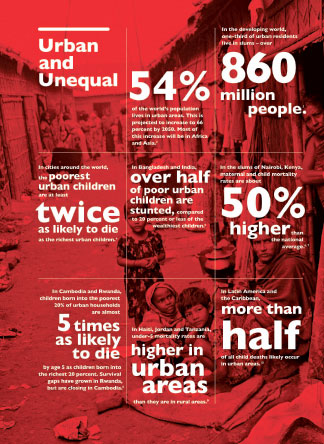Mom's the world!
Sri Lankan mothers ranked the healthiest in South
Asia:
by Husna Inayathullah
Sri Lankan mothers are among the region's healthiest, ahead of other
South Asian neighbours and on par with the Maldives, according to a
recent global assessment.
The State of the World's Mothers Report 2015, ranked Sri Lanka, the
Maldives and Jamaica 92nd - an assessment which measures how much a
country's mothers have their needs as moms met and produce the
healthiest babies.
As opposed to this, Nepal and Bangladesh have remained the same as
last year being placed 114 and 130, respectively.
India has dropped three points since last year and is ranked at 140.
Pakistan and Afghanistan - both countries previously known to have the
worst conditions for mothers and children - have dropped even further.
Afghanistan was ranked at 152, falling from last year's 146, and
Pakistan was ranked at 149, falling from last year's 147.
Urbanization
To celebrate Mother's Day this year, 'Save the Children' published
its 16th annual State of the World's Mothers Report focusing on the
urbanizing world and the pathetic situation mothers and children face to
survive as towns grow and villages shrink.
According to research, among 179 countries, Sri Lanka ranks 92 in
maternal health.
According to the country report in 2014, Maternal Mortality Ratio (MMR)
which is the fifth goal of the Millennium Developing Goals (MDG)
launched recently, Sri Lanka has achieved considerable success in
reducing MMR since the 1940s.
Based on an overall study, the Ministry of Health has estimated the
MMR as 39.3 per 100,000 live births in 2006.
This is considered to be the lowest in South Asia with near universal
access to health care and 98 percent institutional deliveries.
Sri Lanka is on track to meet MDG standards in improving maternal
health but the MMR rates in certain districts in the war- affected areas
and in the Nuwara Eliya districts were still low.
A political commitment to reducing maternal mortality has led to the
expansion of hospitals and clinics in the country, which women were
encouraged to visit for pregnancy care and delivery.
Midwives
 |
| Sri Lankan
mothers with their babies. |
 |
A healthy Sri
Lankan mother with her baby.
Photo: State of the World’s mother’s report (2015) |
Each district in Sri Lanka also has a group of midwives responsible
for providing basic home care for pregnant women and new mothers.
The maternal mortality rate in Sri Lanka fell from 340 maternal
deaths per 100,000 live births in 1960 to just 43 maternal deaths per
100,000 live births in 2005. 98 percent of all births take place in
hospital in Sri Lanka, and 99 percent of women have at least one
antenatal care visit and skilled attendance at delivery.
 Norway, Finland and Iceland top the rankings this year. The top 10
countries are Norway, Finland, Iceland, Denmark, Sweden, Netherlands,
Spain, Germany and Australia. In general, these countries attain very
high scores for mothers' and children's health, educational, economic
and political status. Norway, Finland and Iceland top the rankings this year. The top 10
countries are Norway, Finland, Iceland, Denmark, Sweden, Netherlands,
Spain, Germany and Australia. In general, these countries attain very
high scores for mothers' and children's health, educational, economic
and political status.
The US ranks 33rd. Niger, Congo, Central African Republic and Mali
are some of the countries in the bottom 10 countries. Somalia scores
last among the countries surveyed.
The worst ranked countries are conflict-affected and considered to be
fragile states, which mean they are failing fundamentally to perform
functions necessary to meet their citizens' basic needs.
Every day, all around the world 17,000 children die before reaching
their fifth birthday. Most of these deaths occur in city slums where
overcrowding and poor sanitation exist.
The poorest mothers and children cannot get the care they need.
Urbanization has a positive and negative impact on health. Better access
to health services, education, sanitation and safe water supply which
accompanies urbanization can improve health conditions. When
urbanization is rapid it results in poor sanitary conditions and
overcrowding.
All of which can accelerate the spread of disease and lead to poor
health conditions.
In most developing countries, the poorest urban children are at least
twice as likely to die as the richest urban children. In some countries,
they are three to five or even more times as likely to die.
Reason to be elated
 |
|
Chandrani Bandara, Minister
of Women’s Affairs. |
"The maternal death rate has reduced, thus giving us reason to be
elated," said Minister of Women's Affairs, Chandrani Bandara attributes
it to the successful health programs being carried out by the
Government.
"Sri Lanka has shown remarkable improvement in reducing the maternal
death rate since 1940 due to the national health programs conducted by
the Ministry of Health", she said.
Maternal care has been the focus of the Ministry of Health. Offering
a free health service for sometime now has minimized unequal access to
health care services, specially for women, she said"
"We are happy according to the report, Sri Lanka has achieved a top
slot among 179 countries and is the best place for mothers to be in the
South Asian region', she said.
Health care
In sharp contrast, Sri Lanka and the Maldives were ranked 92nd in the
World's Mothers' Index.
She further said that the midwife was the frontline health worker,
providing health care to mothers and children within the community.
Maternal and child health is an important component of the national
health policy in Sri Lanka, she said. Sri Lanka has a well-developed
health system with a qualified health workforce.
The under five mortality rate per 1000 live births is 9.6 The
government provides pre and post natal care for mothers through family
health workers attached to all Grama Niladari Divisions. Awareness has
been created because of the programs conducted by the government and
mothers were now aware of a child's nutrition.
Breastfeeding in Sri Lanka has increased to 76% in 2007.Sri
Lanka'spoverty has come down and the earning capacity has increased
which has enabled parents to provide a better life for children. |

